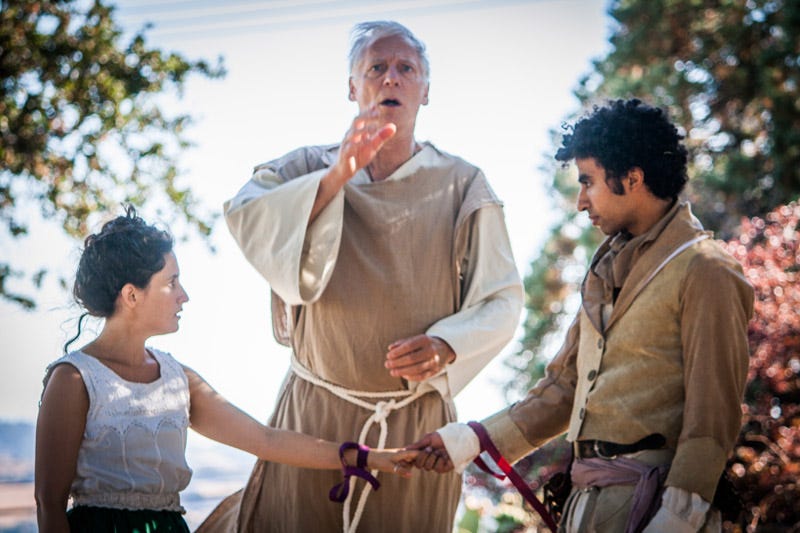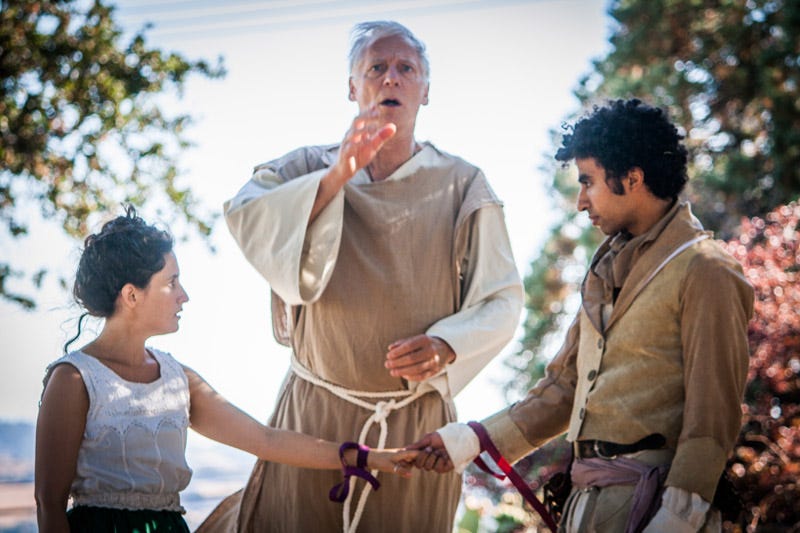
The hardest thing about Romeo and Juliet is that everyone — everyone — knows it. Even before the mandatory confrontation with the text that happens in school, children are usually exposed to the core idea of Shakespeare’s star-crossed lovers.
To choose to reckon with the Bard’s most famous tragic romance is a sign of guts or madness — maybe a little of both. The familiarity of the work acts as both challenge and straightjacket: a temptation to make bold choices that can either illuminate or snuff out the text.
Director Ava Roy’s site-integrated production — that’s We Player’s rather apt term for what we might otherwise call site-responsive plays — takes a number of risks with the material on multiple levels. Not all of them work. We’ll start with what does, and lead with one of the two big aspects of this production that bring this into the No Proscenium universe.
The version of the production that I saw took place at the Petaluma Adobe, a historic site that preserves the two story ranch house of Mariano Guadalupe Vallejo in the rolling Sonoma county plains just east of Petaluma. This is wine country, and there are few things more beautiful in California than wine country. The seemingly endless California drought makes the Adobe feel like it is even more a part of the Old West from which it hails. Best of all, the building defines the aesthetic choices for the production: from costumes to mise-en-scene.
There can be no denying that Roy and company are all-in with the site-integrated concept. They push it, and the grounds deliver. This carries over into the staging, as the balcony scene takes place using — gasp — an actual balcony. Okay, maybe not technically a balcony. I’m not sure what you’re supposed to call the open air part of the second story of an manor-like adobe. Not an architect, so I’m just going with balcony.
It’s not just the building, but the space around the building- — from the glorious old trees to the fields out back which are reserved for the play’s famous final scenes — that become the canvas for the play. Roy does a masterful job constructing stage pictures with the space, and it provides the kind of production value that most set designers would kill for.
The audience proceeded through the action of the play as a processional mass, and that works most of the time. Unfortunately two things trip this up. The first is a simple function of the pacing of the text, as the action picks up scenes begin to fly by and the need to shuttle the audience from one established play area (Friar Lawrence’s Cell, Juliet’s room, etc.) to another can put a dampener on the action. These transitions work best when Roy stages scenes on either side of the audience mass, and when a grand procession into a sequence (the Capulet’s Ball, Juliet’s funeral) occurs.
The second reason why the processions get tripped up is tied into a larger issue that is less about the site-integration, so we’ll hold on that for a moment. I want to stay with the things that make this production of R&J different from a proscenium show.
On top of the non-traditional staging We Players try their hand at some audience interaction. It’s a bit hit or miss, to my eye. It works swimmingly well in the context of the transition into the Capulet ball, which might have something to do with the fact that the company had a number of stand alone events focusing on that sequence. It’s a natural fit for immersion — all the Capulets dancing, and the renegade Montagues sneaking in on the fun. The audience on the evening I saw it was a little reluctant to join in at first, but the production wisely gave them time to breath and find their feet. That’s important when it comes to audience participation: an accepted invitation always seems to produce better results than a command.
Get Noah J Nelson’s stories in your inbox
Join Medium for free to get updates from this writer.
SubscribeSubscribe
However the sequence which ends the ball — suddenly Friar Lawrence is there for a religious ceremony centered around water — feels a bit stapled on. So too does a religious bit later, after the death of Juliet. But these incongruities are as likely to be symptoms of the thing that didn’t work for me at all about the play.
Remember how I started this piece talking about how familiarity with the text invites bold choices? Ones that can either illuminate or snuff out the text? Well, We Players made a very bold choice: to play Romeo and Juliet as, largely, a comedy.
It’s something anyone who has seriously wrestled with the text, or gotten tired of watching the same beats played over and over, has probably considered. After all: taken from a rational point of view there are no two stupider lovers in all of Shakespeare. Two teenagers who let their lust get the better of them and in so doing get a whole lot of people killed.
That is, if you’re willing to let the most cynical voices in your head take over.
The text almost supports this interpretation. By itself the balcony scene, when played for laughs, is a kind of revelation. So much of Romeo’s language when viewed through this lens is revealed to be absurd, and Juliet’s that of a young woman having trouble repressing her natural urges despite what society wants her to do.
It’s an interesting intellectual exercise, but it also robs the play of its punch. For one: the comedic characters are taken out of the role of comic relief for the melodramatic events of the story and pushed into broader clownish roles. One of those characters is tasked with guiding the audience much of the time, and so that comic sensibility is pushed on to almost every scene as a button — no matter what the tone of the previous action was. Even when the actor tries to bring the mood down, it still reads as comic.
Worst of all it creates a barrier to really buying into the lover’s plight. It’s just hard to care about the perils those two face when their sheer stupidity is hit so squarely on the head. This activates the age old problem with ironic distance: if the people telling the story are more interested in commenting on the characters than empathizing with them, then why should the audience?
This choice might work better in a proscenium show. One where the audience is given a physical distance. As it stands I can’t really recall seeing comedy truly work in an open frame production. I’m sure it can, but I’ve got the feeling that it’s a higher level of difficulty to sustain a liminal space while also getting an audience to laugh. To do that in the context of a story that — through design or convention — fights the addition of comedy at almost every step of the way… well, it just becomes too much.
I could see in the outline of the action that Roy and company intended to start with a broad comic energy and then let the violence of the later acts ground the piece into something moving, maybe even shocking. To go from laughing so hard only to be driven to tears. It’s a noble goal, one whose aim is written in what should be a haunting final series of tableaux: each of the surviving cast members isolated in their grief.
Unfortunately that beat goes unearned, as the vein of tragedy is left untended by a monotonous tone over the first few acts. The cast certainly gives it their all, and a few of the scenes work — but they do so at the expense of the overall arc of the narrative.
We Player’s Romeo & Juliet moves to the Villa Montalvo in Saratoga, CA to complete its run. October 6–16th.




















Discussion